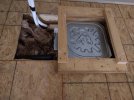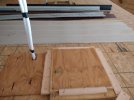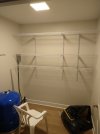We made a little progress over the last week. The HVAC installer came out and worked on the programming. It looks like I can now set the heat down to 50 degrees at least (would have like 40 as a minimum set point) and set back scheduling is now available on the menu. The next thing we worked on was barn lighting. I decided not to have the contractor put in the lighting and may it a DIY project. I bought some of these LED UFO lights:
https://www.amazon.com/gp/product/B08DHGP5GB/ref=ppx_yo_dt_b_asin_title_o01_s00?ie=UTF8&psc=1
We can't get the final inspection and the Certificate of Occupancy (CO) until the 3B work is done on the well. I don't want to have any electrical open when the county comes for the final inspection, so I'm limited in what I can do until that occurs. We did do the lighting layout and installed the hooks to physically hang the UFO lights. The barn door openers are plug-in so there is an outlet near each of them. The UFO lights are direct wire, so we stopped at Lowes and picked up a plug and an extension cord. I also bought a forced air propane heater from Lowes:
https://www.lowes.com/pd/DEWALT-DEW...Portable-Forced-Air-Propane-Heater/1001045892 I just took one of my propane tanks off the trailer at the farm. They have not been used since I got the big 320 gal propane tank and hooked it up to the trailer. This kept us toasty as we worked.
I opened one of the UFO lights and attached the plug. I then got on a ladder, plugged it in, and held it up so my wife could see the footprint on the floor. Based on that, we decided where to put lights for general lighting in the barn. Once I get a shop setup in a few years, I'll work on more specific lighting if I need it. I had purchased 4 of the UFO and we decided we needed 5 to cover the barn. We put up the hooks at the appropriate locations and I ordered one more two-pack of lights. We will use the last one eventually in the basement of the new house where we will have a butchering station setup for processing deer. The wiring will need to wait for the CO.
That brings us to the next problem, insurance. A couple years ago someone applies for credit in my name. It was quickly caught, but I put credit freezes on with the big three. For some reason, baffling to me, insurance companies want access to your credit report to sell you insurance. For some reason I was having trouble lifting the freezes but I finally got that worked out. That must not have been the issue because the insurance company is still having issues. I've learned a lot through the process. The insurance company can add it to my current homeowners policy and an "other structure" but only until the OC is issued. They can do that immediately without a credit check. That is good since the builder's risk policy just expired. Once the OC is issued it needs it's own policy. So, I've told the builder to get the 3B work finished on the well as soon as he can but to hold off on calling the county for the final inspection until the insurance company can work out their glitch with the credit bureaus. Once that happens, I'll give him the go ahead to call the county. As soon as the policy is issued, I'll freeze the credit again with the big three.
We did this work between trips looking at mini-excavators:
https://habitat-talk.com/index.php?threads/mini-excavator.12269/ If I get one of these, I'll use it to deal with driveway drainage as well as the final grading. I wish I had it as our next project was cleaning up a couple oaks that were uprooted during the recent ice storm we had. I got lucky. They fell across the field right where I planted fruit trees. They fell exactly between the cages and did not hurt a single one! I took over my new Dewalt chainsaw and cut it up. There is still some more that needs done, but I'll need to bring the Kioti over when it dries out (unless I get a mini-excavator in the meantime) to finish it.
I hope John gets the picture posting issue resolved soon and I'll post some more pics.
Thanks,
Jack



